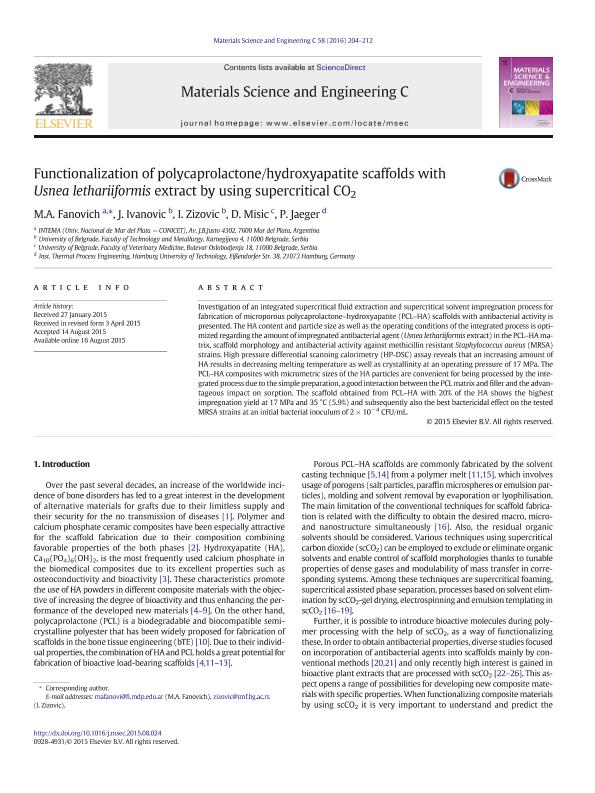Artículo
Functionalization of polycaprolactone/hydroxyapatite scaffolds with Usnea lethariiformis extract by using supercritical CO2
Fecha de publicación:
01/2016
Editorial:
Elsevier Science
Revista:
Materials Science and Engineering: C
ISSN:
0928-4931
Idioma:
Inglés
Tipo de recurso:
Artículo publicado
Clasificación temática:
Resumen
Investigation of an integrated supercritical fluid extraction and supercritical solvent impregnation process for fabrication of microporous polycaprolactone-hydroxyapatite (PCL-HA) scaffolds with antibacterial activity is presented. The HA content and particle size as well as the operating conditions of the integrated process is optimized regarding the amount of impregnated antibacterial agent (Usnea lethariiformis extract) in the PCL-HA matrix, scaffold morphology and antibacterial activity against methicillin resistant Staphylococcus aureus (MRSA) strains. High pressure differential scanning calorimetry (HP-DSC) assay reveals that an increasing amount of HA results in decreasing melting temperature as well as crystallinity at an operating pressure of 17 MPa. The PCL-HA composites with micrometric sizes of the HA particles are convenient for being processed by the integrated process due to the simple preparation, a good interaction between the PCL matrix and filler and the advantageous impact on sorption. The scaffold obtained from PCL-HA with 20% of the HA shows the highest impregnation yield at 17 MPa and 35 °C (5.9%) and subsequently also the best bactericidal effect on the tested MRSA strains at an initial bacterial inoculum of 2 × 10- 4 CFU/mL.
Palabras clave:
Scaffolds
,
Polycaprolactone
,
Supercritical Fluid
Archivos asociados
Licencia
Identificadores
Colecciones
Articulos(INTEMA)
Articulos de INST.DE INV.EN CIENCIA Y TECNOL.MATERIALES (I)
Articulos de INST.DE INV.EN CIENCIA Y TECNOL.MATERIALES (I)
Citación
Fanovich, Maria Alejandra; Ivanovic, J.; Zizovic, I.; Misic, D.; Jaeger, P.; Functionalization of polycaprolactone/hydroxyapatite scaffolds with Usnea lethariiformis extract by using supercritical CO2; Elsevier Science; Materials Science and Engineering: C; 58; 1-2016; 204-212
Compartir
Altmétricas




